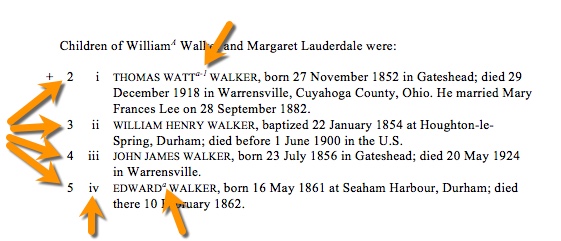Numbering a Genealogy 1: Immigration
-
Created on 30 March 2016
By Judy Kellar Fox, CG®
Meet the Walkers: William, Margaret, their children, and grandchildren. In several posts we will use this family to explore issues encountered when numbering a genealogy, one of the relationship-formatting options of Standard 65, Genealogical formats.[1] This first post will show how to number the Walker family abroad and after immigration to the United States. Successive posts will show how to number adoptive children, those of unknown paternity, and children of successive spouses.
In all cases our authority on numbering is Joan Ferris Curran, Madilyn Coen Crane, and John H. Wray, Numbering Your Genealogy: Basic Systems, Complex Families, and International Kin, ed. Elizabeth Shown Mills, rev. ed. (Arlington, Va.: National Genealogical Society, 2008). Posts assume readers are familiar with writing a genealogical sketch that covers basic vital information.[2] The examples are highly abbreviated and omit source citations to save space.
Part of the genealogical sketch, the parenthetical summary of descent, outlines each descendant’s ancestry. It appears after the descendant’s name in the first line of the biographical sketch, for example, “8. Margaret Maitland2 Walker (Thomas Watta-1, WilliamA, ThomasB) was born . . .”
We will be focusing on three numbers. All can be seen in the entries for William and his family below.
- Individual numbers are arabic numerals (1, 2, 3, 4, etc.) that uniquely identify each descendant in the genealogy. They begin with the first person in the genealogy, the progenitor (William Walker here), and continue sequentially with his children in birth order.[3] The sequence continues with the children of Generation Two and succeeding generations. Each person has a unique number. Spouses do not receive an individual number, as they belong to the genealogy of another surname.
- Generation numbers are superscript numbers or letters in italic font (1, 2, A, B, a, b) that designate a person’s generation. They appear after the first names of 1) each individual and 2) each person in the parenthetical summary of descent.[4] Whether to use letters or numbers depends on where the person was born. In the simplest terms, letters of the alphabet designate foreign-born people, and numbers designate those who immigrated to or were born in the American colonies or the United States.[5] Capital letters indicate those who stayed in the home country, beginning with A, the parent of the immigrant(s), and increasing with each more distant ancestor. Lowercase letters indicate successive generations of foreign-born descendants, beginning with a.[6]
- Birth-order numbers are lower case roman numerals (i, ii, iii, iv) that indicate placement of children in a family. They are assigned sequentially to all children of the couple in question. William and Margaret had four children, numbered i–iv.
Generation One
William has an individual number (1) and an italic superscript (A) for his generation. His father also has a generation number in William’s parenthetical summary of descent.
Individual number and generation "numbers"
Did you notice how we worked with the numbering system and the Numbering Your Genealogy examples to justify WilliamA’s individual and generation numbers? We didn’t make them up. There’s a reason for each one. Let’s see how the numbering plays out for William’s children.
Each of William and Margaret’s children has both an individual number and a birth-order number. While the individual numbers place them in the context of the whole genealogy, the birth-order numbers refer only to this particular family.
After WilliamA’s death, all of his children immigrated to the U.S. with their mother. Those children take a two-part generation number, a-1: a, because they are children of a parent who did not immigrate and 1, because they themselves did immigrate.[7]
The generation number of eldest son Thomas Watt, a-1, is implied for younger brothers William Henry and John James.[8] However, their youngest brother Edward died in England before the immigration. He is simply generation a, the child of A, William. His generation number tells us at a glance (by the lack of a number 1) that he did not immigrate with the others.[9]
Individual numbers, birth-order numbers, and generation numbers
That’s a skeleton of William Walker’s biological family. What it doesn’t show is that Margaret gave birth to a daughter Margaret Ann a year or so after William’s death. She, too, bears the Walker surname, so how does she fit in this genealogy? Next time we’ll look at Margaret Ann, and the complexity of children of unknown parentage.
How does the Walkers’ numbering compare to your family’s? What questions does it raise?
[1] Board for Certification of Genealogists, Genealogy Standards, 50th Anniversary ed. (Nashville, Tenn.: Ancestry Imprint, Turner Publishing, 2014), 36–37.
[2] For examples, see issues of the National Genealogical Society Quarterly that include winning submissions of the NGS Family History Writing Contest (usually December). For guidance on writing a genealogical sketch see Carmen J. Finley, Creating a Winning Family History: Including a Guide to the NGS Family History Writing Contest, rev. ed. (Arlington, Va.: National Genealogical Society, 2010), 31, section (1).
[3] Numbering Your Genealogy, 9.
